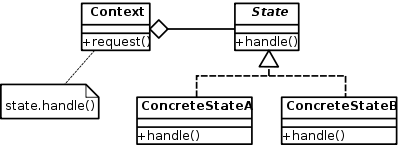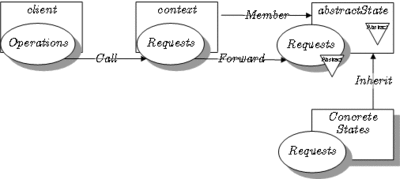State pattern
The state pattern, which closely resembles Strategy Pattern, is a behavioral software design pattern, also known as the objects for states pattern. This pattern is used in computer programming to encapsulate varying behavior for the same routine based on an object's state object. This can be a cleaner way for an object to change its behavior at runtime without resorting to large monolithic conditional statements.[1]:395
Structure
Example
Pseudocode
Take, for example, a drawing program. The program has a mouse cursor, which at any point in time can act as one of several tools. Instead of switching between multiple cursor objects, the cursor maintains an internal state representing the tool currently in use. When a tool-dependent method is called (say, as a result of a mouse click), the method call is passed on to the cursor's state.
Each tool corresponds to a state. The shared abstract state class is AbstractTool:
class AbstractTool is
function moveTo(point) is
input: the location point the mouse moved to
(this function must be implemented by subclasses)
function mouseDown(point) is
input: the location point the mouse is at
(this function must be implemented by subclasses)
function mouseUp(point) is
input: the location point the mouse is at
(this function must be implemented by subclasses)
According to this definition, each tool must handle movement of the mouse cursor and also the start and end of any click or drag.
Using that base class, simple pen and selection tools could look like this:
subclass PenTool of AbstractTool is
last_mouse_position := invalid
mouse_button := up
function moveTo(point) is
input: the location point the mouse moved to
if mouse_button = down
(draw a line from the last_mouse_position to point)
last_mouse_position := point
function mouseDown(point) is
input: the location point the mouse is at
mouse_button := down
last_mouse_position := point
function mouseUp(point) is
input: the location point the mouse is at
mouse_button := up
subclass SelectionTool of AbstractTool is
selection_start := invalid
mouse_button := up
function moveTo(point) is
input: the location point the mouse moved to
if mouse_button = down
(select the rectangle between selection_start and point)
function mouseDown(point) is
input: the location point the mouse is at
mouse_button := down
selection_start := point
function mouseUp(point) is
input: the location point the mouse is at
mouse_button := up
For this example, the class for the context is called Cursor. The methods named in the abstract state class
(AbstractTool in this case) are also implemented in the context. In the context class, these methods invoke the corresponding method of the current state, represented by current_tool.
class Cursor is
current_tool := new PenTool
function moveTo(point) is
input: the location point the mouse moved to
current_tool.moveTo(point)
function mouseDown(point) is
input: the location point the mouse is at
current_tool.mouseDown(point)
function mouseUp(point) is
input: the location point the mouse is at
current_tool.mouseUp(point)
function usePenTool() is
current_tool := new PenTool
function useSelectionTool() is
current_tool := new SelectionTool
Notice how one Cursor object can act both as a PenTool and a SelectionTool at different points, by passing the appropriate method calls on to whichever tool is active. That is the essence of the state pattern. In this case, we could have combined state and object by creating PenCursor and SelectCursor classes, thus reducing the solution to simple inheritance, but in practice, Cursor may carry data that is expensive or inelegant to copy to a new object whenever a new tool is selected.
Java
The state interface and two implementations. The state’s method has a reference to the context object and is able to change its state.
interface Statelike { void writeName(StateContext context, String name); } class StateLowerCase implements Statelike { @Override public void writeName(final StateContext context, final String name) { System.out.println(name.toLowerCase()); context.setState(new StateMultipleUpperCase()); } } class StateMultipleUpperCase implements Statelike { /** Counter local to this state */ private int count = 0; @Override public void writeName(final StateContext context, final String name) { System.out.println(name.toUpperCase()); /* Change state after StateMultipleUpperCase's writeName() gets invoked twice */ if(++count > 1) { context.setState(new StateLowerCase()); } } }
The context class has a state variable that it instantiates in an initial state, in this case StateLowerCase. In its method, it uses the corresponding methods of the state object.
class StateContext { private Statelike myState; StateContext() { setState(new StateLowerCase()); } /** * Setter method for the state. * Normally only called by classes implementing the State interface. * @param newState the new state of this context */ void setState(final Statelike newState) { myState = newState; } public void writeName(final String name) { myState.writeName(this, name); } }
The demonstration below shows the usage:
public class DemoOfClientState { public static void main(String[] args) { final StateContext sc = new StateContext(); sc.writeName("Monday"); sc.writeName("Tuesday"); sc.writeName("Wednesday"); sc.writeName("Thursday"); sc.writeName("Friday"); sc.writeName("Saturday"); sc.writeName("Sunday"); } }
With the above code, the output of main() from DemoOfClientState should be:
monday TUESDAY WEDNESDAY thursday FRIDAY SATURDAY sunday
See also
- Finite State Machine
- Strategy pattern
References
- ↑ 1.0 1.1 Erich Gamma; Richard Helm, Ralph Johnson, John M. Vlissides (1995). Design Patterns: Elements of Reusable Object-Oriented Software. Addison-Wesley. ISBN 0-201-63361-2.
- ↑ 2.0 2.1 State pattern in UML and in LePUS3
- ↑ legend
External links
| The Wikibook Computer Science Design Patterns has a page on the topic of: State implementations in various languages |
| ||||||||||||||||||||||||||||||||||||||||

